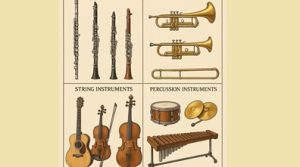Definition of Andante in Music

Definition of Andante in Music
This moderate tempo brings a calm and flowing sometimes, introspective atmosphere into musical works.
Andante in Music: What is Andante?
Andante is sometimes described as ‘steady,’ ‘measured,’ and ‘easy-going.’
It generally tells a player to play the mark for them and at that tempo associated with smoothness, ebb, and flow, much like a natural feeling, which could be taken up as easy, lyrical motion.
What Is the Speed of Andante?
Because andante means “a walking pace,” the actual speed is somewhat subjective; but, for purposes of precision, musicians often measure it out on a metronome.
Andante generally figures as 76 to 108 beats per minute (BPM) on a metronome.
That gives an objective guideline, though individual interpretation continues to play a role in ensuring that the desired expression emerges.
What is the Origin of Andante?
Some composers in the Baroque period have sometimes coined terms to qualify pieces of moderate tempo, such as Vivaldi,
Handel, and Bach. Andante became important during the Classical period and was used often by Mozart and Haydn.
During the transition of music into the Romantic period, composers like Beethoven and Brahms were still fond of using andante to attach profundity and nuances to their works.
Historical Context and Etymology
It began to come into general use in the mid-1700s when composers were in the process of moving from the profuse embellishment of Baroque music to the orderly elegance of the Classical period.
Mozart and Haydn mastered the use of andante to express a vast spectrum of emotions, from tender warmth to deep reflection.
Not just that: beyond being tempo, andante had also become part of a much broader musical philosophy.
For an age that prized equilibrium, clarity, and form, the phrase lent itself to great exploration of such ideals in the arts.
Such kinds of imports elicited emotional responses even as they were highly structured, thus giving listeners an experience that was deep yet contained.
Subtypes of Andante
Andante considered one tempo marking in its own right to have several variations and subtypes that intend to suggest different meanings.
Among those frequently used are:
- Andante moderato: A little faster than moderate often allows energy or momentum to come through.
- Andante cantabile: Legato andante, a singing andante, gives it more smoothness and fluidity.
- Andante sostenuto: A sustained andante often used when passages are dramatic or intense.
Connections to Andante
- Andantino: A little faster than, or occasionally slower than andante, it has something of a lightness or gracefulness to its movement. One might find it around 80-108 BPM.
- Andante moderato: Between the two; a little faster than-andante but not so speedy as to be mistaken for traveling (80-108 BPM).
- Andante con moto: It means “andante with movement “; there should be, therefore, a slightly more lively pace controlled and steady.
- Andante sostenuto: Sustained andante would seem to suggest a somewhat lingering, elongated pace wherein notes and phrases would be stretched for expressive purposes.
- Andante tranquillo: Thus combining the steady flow of andante with a deep tranquil character in its effect, this tempo therefore stresses the smoothness and tranquility of the music.
- Andante maestoso: Andante with majesty is movement dignified and stately, often with grandeur, yet though not devoid of majesty.
- Andante cantabile: Indicating to be “tek-able or song-like andante,” this tempo gives a flowy feel to the piece, as has a lyrical expressiveness similar to a vocal melody.
- Andante grazioso: In De Alto, often translated as “graceful andante,” it foregrounds elegance and delicacy – finesse to create lightness and charm.
- Andante espressivo: Deeply emotional by this marking, phrasing will be flexible, nuanced, and expressive within a stearate.
- Andante Allegretto: This is an andantino to allegretto, but between when movement is rather relaxing and slightly lively, it makes a grand soft charge.
Andante in Different Genres of Music
It appears in many genres of music: Including classical:
Composers like Mozart would use andante with other tempo markings like allegro and adagio, and thus also used by Beethoven and Brahms. – Choral:
Mostly andante is used in choral works or hymns to denote solemnity or reflective quality.
Jazz and Popular music:
You can hear this in jazz and pop compositions that might use andante to reflect a more chill or mellow feel, often in conjunction with slow or medium tempos.
Film Scores
Andante in film soundtracks is typically useful to impart nostalgia or wistfulness into the emotional setting of the story.
These examples display the many facets of andante and show the extent of emotion and representation that you can portray through andante in music.
Andante Interpretation Tips
For the performer, andante interpretation involves understanding the depth of the composer’s ideas and the reasoning behind the piece.
Here are certain fundamental things to note while achieving a good andante performance:
Listen to the complete design:
Listen to how the andante tempo helps bring shape and progress through the whole piece.
Recognize the phrase:
More specifically, voice the breaths since these will count towards the expression of andante.
Experiment with dynamics:
Adding or changing dynamics can give another dimension to the andante tempo and make it more interesting.
Practice regularly:
Like any other tempo marking, andante takes constant practice for the developing and keeping it in balance and involvement.
Final Remark
Andante fulfills the role of a semi-weight mark of musical notation, suggesting and bringing in quietness, rest, and contemplation.
You can use it from classics to contemporary compositions and retains its appeal and versatility as an ever-living tempo.
Understanding a little more about its origin and various types of approaches to it can open previously unexplored avenues to a more profound appreciation of the art of musical composition and interpretation by performers and enthusiasts.
Moreover, from the classical to the jazz and popular music forms, andante has been to date an important and timeless polestar in musical expression.
Frequently Asked Questions
How does the term andante feature as an antithesis to other sections in musical works?
Andante is one of those terms that are alive with activity in a depiction of something dynamic, such as fast contrasts with “la facile” movements in a sentence segmented by other courses of action by an emphasis on its use.
Just as it renders contrast, so that one element indulges, and thus brings forth or among smoothened scenes, it would decelerate progression: lengthy notes or easy-flowing melody will encourage the audience to breathtaking meditation and responses.
What does Andante do to enrich and deepen musical expression?
Each interpretation of andante brings new ideas into a piece, thus adding to its multi-layering meaning.
Such scope of expression adds much more than understanding; it increases the ability to appreciate the work in differing ways, unleashing creativity.
Different performances open doors to new artistic possibilities while keeping within the bounds established by the composer.

This encourages co-partnership and exchange enrichment in discourse, leading toward a more vibrant musical landscape.





